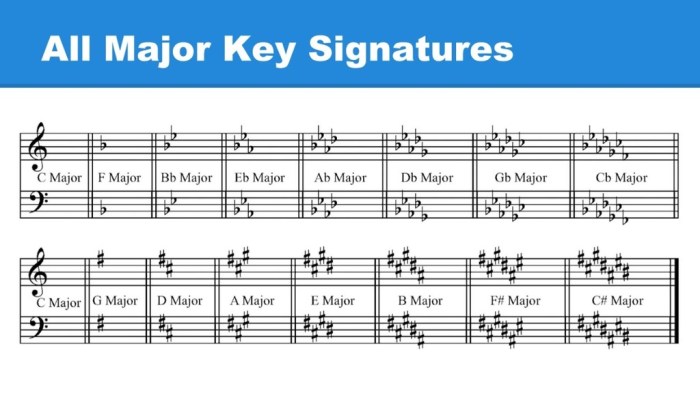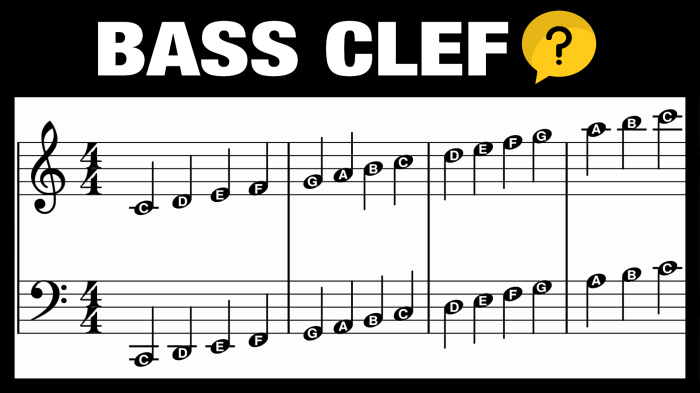Welcome to the world of e major triad bass clef, a fundamental building block of Western music. Join us as we explore its construction, inversions, and uses in a manner that is both informative and engaging.
Throughout this guide, we’ll delve into the intricacies of the e major triad, providing step-by-step instructions, musical examples, and historical insights.
Definition of E Major Triad

In music theory, a triad is a chord consisting of three notes. The E major triad is a specific type of triad that is composed of the notes E, G#, and B.
Root, Third, and Fifth Intervals
The root of a triad is the lowest note in the chord. In the case of the E major triad, the root is E.
The third of a triad is the note that is three scale steps above the root. In the E major triad, the third is G#.
The fifth of a triad is the note that is five scale steps above the root. In the E major triad, the fifth is B.
Construction of E Major Triad in Bass Clef

The E major triad in bass clef is constructed by stacking the notes E, G#, and B on top of each other, with E as the root note at the bottom.
Step-by-Step Guide:
- Locate the E note on the second line from the bottom of the bass clef. This is the root note of the triad.
- Move up four half steps from E to reach G#. G# is on the third space from the bottom of the bass clef.
- Move up another four half steps from G# to reach B. B is on the fourth line from the bottom of the bass clef.
The resulting stack of notes (E, G#, B) forms the E major triad in bass clef.
Illustration:
“` E G# B“`
The e major triad bass clef is a fundamental musical concept. If you’re interested in learning more about government, check out ap gov chapter 10 vocab for an in-depth exploration of key terms. Returning to our musical discussion, the e major triad bass clef provides a solid foundation for understanding music theory.
Inversions of E Major Triad
In music theory, an inversion occurs when the lowest-sounding note of a chord is not the root. In the case of the E major triad, there are three possible inversions:
First Inversion
In the first inversion, the third of the chord (G#) becomes the lowest note. The triad is now written as G#-E-B.
Second Inversion
In the second inversion, the fifth of the chord (B) becomes the lowest note. The triad is now written as B-G#-E.
Third Inversion
In the third inversion, the seventh of the chord (D#) becomes the lowest note. The triad is now written as D#-B-G#.
Uses of E Major Triad in Music: E Major Triad Bass Clef

The E major triad is a versatile and commonly used chord in Western music. It consists of the notes E, G#, and B, and it serves various harmonic functions in different musical contexts.
Harmonic Functions and Progressions
In tonal music, the E major triad can act as a tonic, subdominant, or dominant chord. As the tonic, it establishes the tonal center of a piece. As the subdominant, it provides a sense of stability and movement towards the dominant.
As the dominant, it creates tension and resolves to the tonic.
Common harmonic progressions involving the E major triad include:
- I – IV – V (tonic – subdominant – dominant)
- I – vi – ii – V (tonic – minor submediant – minor mediant – dominant)
- I – V – vi – iii (tonic – dominant – minor submediant – minor tonic)
Examples in Musical Contexts
The E major triad appears in a wide range of musical genres, including classical, jazz, and pop. Here are some examples of its use:
- In Beethoven’s “Für Elise,” the E major triad serves as the tonic chord, establishing the tonal center of the piece.
- In Miles Davis’ “So What,” the E major triad is used as a dominant chord, resolving to the tonic chord (D minor).
- In Ed Sheeran’s “Shape of You,” the E major triad is used as a subdominant chord, providing a sense of movement towards the dominant (A major).
Variations and Extensions of E Major Triad

The E major triad forms the foundation for many musical compositions. However, musicians often extend and vary the triad to create richer and more complex sounds.
Extended Versions
One common extension is adding a seventh interval, resulting in an E major seventh chord (E-G#-B-D#). This extended chord adds a dissonant element that can create tension and movement in music.
Variations in Voicings and Inversions, E major triad bass clef
Musicians can also vary the triad by changing the order of the notes (voicing) or inverting the chord.
- Voicings:Different voicings can alter the overall sound of the chord. For example, placing the G# note in the bass instead of the E creates a richer and fuller sound.
- Inversions:Inversions involve rearranging the notes of the triad so that a different note becomes the bass note. The first inversion of E major (E-B-G#) places the B note in the bass, creating a softer and more subtle sound.
These variations and extensions allow musicians to create a wide range of harmonic possibilities from a single E major triad.
Comparison to Other Major Triads
The E major triad shares similarities with other major triads in terms of their construction and sound. All major triads consist of a root note, a major third, and a perfect fifth. However, each triad has a unique pitch and sound due to the specific notes that make it up.
Similarities
- All major triads have a major third (4 semitones) between the root and the third.
- All major triads have a perfect fifth (7 semitones) between the root and the fifth.
- All major triads have a bright and consonant sound.
Differences
- The root note of each triad is different, resulting in a different overall pitch.
- The specific notes that make up each triad are different, giving each triad its own unique sound.
| Triad | Root Note | Major Third | Perfect Fifth |
|---|---|---|---|
| C Major | C | E | G |
| G Major | G | B | D |
| E Major | E | G# | B |
Historical and Cultural Context of E Major Triad

The E major triad, with its harmonious and uplifting sound, has a rich history deeply intertwined with the evolution of Western music. Its origins can be traced back to ancient Greece, where it was used in both secular and religious music.
Throughout the centuries, it has played a pivotal role in various musical styles and periods.
In the Middle Ages, the E major triad formed the basis of many Gregorian chants and polyphonic compositions. During the Renaissance, it gained prominence in vocal and instrumental music, particularly in the works of composers such as Josquin des Prez and Palestrina.
The Baroque era saw the triad’s continued use in instrumental music, notably in the concertos and sonatas of Bach and Handel.
Use in Classical Music
In the Classical period, the E major triad became a cornerstone of harmonic structure. Composers like Haydn, Mozart, and Beethoven employed it extensively in their symphonies, concertos, and chamber music. It provided a sense of stability and resolution, often serving as the tonic triad in major-key compositions.
Use in Romantic Music
During the Romantic era, the E major triad retained its importance but was often used with greater expressive freedom. Composers like Chopin, Schumann, and Liszt explored its emotional potential, employing it in both lyrical and dramatic contexts. The triad’s association with triumph and joy made it a popular choice for celebratory works.
Use in 20th-Century Music
In the 20th century, the E major triad continued to be a fundamental element in Western music. It found its way into jazz, blues, and popular music, where it played a crucial role in harmonic progressions and improvisation. Notable examples include the use of the E major triad in Duke Ellington’s “It Don’t Mean a Thing (If It Ain’t Got That Swing)” and The Beatles’ “Here Comes the Sun.”
FAQ Corner
What is the root note of the e major triad?
The root note is E.
How many inversions does the e major triad have?
It has three inversions.
What is the function of the e major triad in music?
It often serves as a tonic chord, providing stability and resolution.